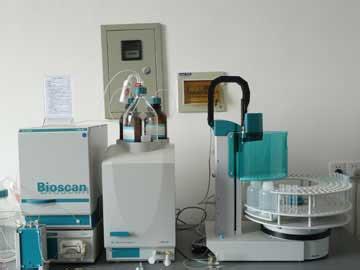Application Analysis of Laboratory Ion Chromatograph
 Ion chromatography is a liquid chromatography method used to separate organic and inorganic ions that can dissociate in water and is a type of high performance liquid chromatography. Since its inception in the mid-1970s, it has quickly become an important analytical tool for cations and cations in aqueous solutions. Applications range from analysis of common anions, cations, and organic acids in water to the analysis of polar organic compounds and sugars, amino acids, peptides, and proteins in biological samples.
Ion chromatography is a liquid chromatography method used to separate organic and inorganic ions that can dissociate in water and is a type of high performance liquid chromatography. Since its inception in the mid-1970s, it has quickly become an important analytical tool for cations and cations in aqueous solutions. Applications range from analysis of common anions, cations, and organic acids in water to the analysis of polar organic compounds and sugars, amino acids, peptides, and proteins in biological samples. Characteristics of Ion Chromatography Methods Determination of ionic compounds is the main content of classical analytical chemistry. There are some rapid and sensitive analytical methods for the analysis of cations, such as atomic absorption, high-frequency inductively coupled plasma emission spectroscopy, and X-ray fluorescence analysis. The analysis of anions has long lacked a rapid and sensitive method. The classic volumetric, gravimetric and photometric methods have been used. These method steps are lengthy, time-consuming, sensitive, and susceptible to interference. The developed ion chromatography overcomes the above drawbacks and has the advantages of rapidity, high sensitivity, good selectivity, and the ability to measure multiple components simultaneously. It can be said that the analysis of anions by ion chromatography is a new breakthrough in analytical chemistry.
Fast and convenient analysis of seven common anions (F-, Cl-, Br-, NO3-, NO2-, SO42-, PO43-) and six common cations (Li, Na, NH4, K, Mg2, Ca2) The time is less than 10min. For example, the separation time of the above-mentioned seven common anions can be as short as 3 minutes.
The high sensitivity of the ion chromatography ranged from μg/L to mg/L. When the injection volume was 50 μl, the detection limit of common anions was less than 10 μg/L. If you increase the injection volume and use a small aperture column (2mm diameter) or online concentration, the detection limit can reach 10-12g/L.
Selective IC methods for the analysis of the selectivity of inorganic and organic cations and cations are mainly achieved by the selection of appropriate separation and detection systems. Due to the selectivity of the IC, the pretreatment of the sample is simple, and dilution and filtration are generally required.
Simultaneous determination of multiple ionic compounds Compared to photometric, atomic absorption methods, the main advantage of ICs is the simultaneous detection of multiple components in a sample in a short time.
Separation column with good stability, high capacity IC styrene / divinylbenzene polymer is the most widely used filler. The high pH stability of this resin allows the use of strong acids or alkalis as eluents, which is beneficial for expanding the range of applications. Dissolving, diluting, and filtering are the main tasks of pretreatment when analyzing samples.
The machine frame adopts the manufacturing process of integral welding and overall tempering to achieve better precision and strength. It is equipped with 5 drilling heads to produce all kinds of brushes.The machine has wide application range, high processing speed, high output and good stability. It is also equiped with the human-machine touch screen control system, Chinese and English display, and the large amount of memory for editing simple brush program. The operation is flexible and convenient. All the parts are designed according to the standard, the hair mouth, the plucking knife and the needle are designed according to European standards, and all the parts of the same series can be used by each other. As for the colour, both two colour or single colour wire are available, the machine can be drilled and planted separately. Finally, the machine`s parts has long service life for it is installed with the automatic lubrication system.
Technical Parameters:
Model: LBS70
Workbench axis number (axis): 5
Production speed (hole / min): ≦450
Number of stations (a):6
Tufting head range (mm): 70
filament length range (mm) :50-280
Brush plate maximum length (mm) :600
Hole diameter range (mm): 2.2-8
Rated voltage\frequency (V.Hz): 380.50
Machine Power (KW): 4.5
Air source input pressure (Mpa) :0.8
Weight (kg): 3000
Dimensions (L*W*H) mm: L2770*W2100*H2100
5 Axes 5 Heads Drill And Tuft Brush Machine
5 Axis 5 Heads Brush Machine,Drill and Tufting Super Brush Machine,Industrial Brush Tufting Machine,Tufting Drilling Machine Brush Making Machine
Yangzhou Blue State Digital Control Brush Equipment Co., LTD. , http://www.lbbrushmachine.com